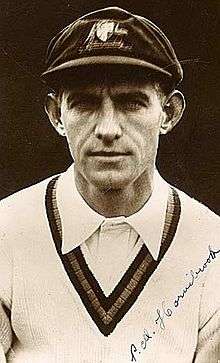Percy Hornibrook
 | ||||||||||||||||||||||||||||||||||||||||
| Cricket information | ||||||||||||||||||||||||||||||||||||||||
|---|---|---|---|---|---|---|---|---|---|---|---|---|---|---|---|---|---|---|---|---|---|---|---|---|---|---|---|---|---|---|---|---|---|---|---|---|---|---|---|---|
| Batting style | Left-hand bat | |||||||||||||||||||||||||||||||||||||||
| Bowling style | Left-arm slow medium | |||||||||||||||||||||||||||||||||||||||
| International information | ||||||||||||||||||||||||||||||||||||||||
| National side | ||||||||||||||||||||||||||||||||||||||||
| Career statistics | ||||||||||||||||||||||||||||||||||||||||
| ||||||||||||||||||||||||||||||||||||||||
| Source: Cricinfo | ||||||||||||||||||||||||||||||||||||||||
Percival Mitchell Hornibrook (27 July 1899, Obi Obi, Queensland – 25 August 1976, Spring Hill, Queensland) was an Australian cricketer who played in 6 Tests from 1929 to 1930.

Career
Hornibrook took 81 wickets at an average of 9, on a tour of New Zealand in 1920. According to Wisden, "Many thought he should have been included in the 1921 side to England, which was distinctly weak in slow-wicket bowling, though in the event it not require it."[1]
Wisden later said "There was far greater surprise when he was omitted from the 1926 side, and no less a judge than M. A. Noble advocated his inclusion. He would at least have saved Macartney from being bowled to death in the early weeks of the tour and in the vital last Test on a rain-affected pitch he might easily have tipped the scales in Australia's favour."
Hornibrook made his test debut in the last game of the 1928-29 Ashes. He took four wickets and made some useful runs in Australia's victory.[2]
1930 Ashes
Hornibrook toured Australia for the 1930 Ashes. He played in all the tests and took 13 wickets in tests.[3] He took 96 wickets on the tour in all, Australia's second best bowler after Clarrie Grimmett.[4]
Hornibrook's best performance came in the 5th test. The series was 1-1, with England only having to draw to retain the Ashes. They batted first and scored 405, with Hornibrook taking no wickets. Australia batted and made 695. When England batted again Hornibrook took 7-92 and England were dismissed for 251.[5]
According to Wisden, "his figures suggest, what good critics confirm, that he bowled far too many bad balls: one indeed said that bogey for a good slow left-hander on that wicket would have been seven for 30. Perhaps had he had longer experience of English conditions he would have been better. At any rate by then he was past his peak--his arm had dropped and he was more full-chested. At the end of the tour he retired from first-class cricket."[1]
He made a comeback to first class cricket in 1933-34.[6] It was not successful but he continued to play club cricket.[7]
Hornibrook retired from club cricket in 1940.[8]
References
- 1 2 Percy Hornibrook Wisden profile
- ↑ http://cricketarchive.com/Archive/Scorecards/12/12972.html
- ↑ http://cricketarchive.com/Archive/Events/0/Australia_in_British_Isles_1930/t_Australia_Bowling.html
- ↑ http://cricketarchive.com/Archive/Events/0/Australia_in_British_Isles_1930/f_Australians_Bowling.html
- ↑ http://cricketarchive.com/Archive/Scorecards/13/13666.html
- ↑ "Percy Hornibrook's Come-back". Sporting Globe. , (1196). Victoria, Australia. 17 January 1934. p. 1 (Edition1). Retrieved 15 April 2016 – via National Library of Australia.
- ↑ "The Cricketer of the Week—No. 3". The Courier-mail (967). Queensland, Australia. 5 October 1936. p. 9. Retrieved 15 April 2016 – via National Library of Australia.
- ↑ "Percy Hornibrook Retires". Sporting Globe. , (1905). Victoria, Australia. 25 September 1940. p. 9 (Edition1). Retrieved 15 April 2016 – via National Library of Australia.